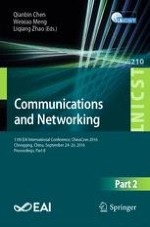The two-volume set LNICST 209-210 constitutes the post-conference proceedings of the 11th EAI International Conference on Communications and Networking, ChinaCom 2016, held in Chongqing, China, in September 2016.
The total of 107 contributions presented in these volumes are carefully reviewed and selected from 181 submissions. The book is organized in topical sections on MAC schemes, traffic algorithms and routing algorithms, security, coding schemes, relay systems, optical systems and networks, signal detection and estimation, energy harvesting systems, resource allocation schemes, network architecture and SDM, heterogeneous networks, IoT (Internet of Things), hardware design and implementation, mobility management, SDN and clouds, navigation, tracking and localization, future mobile networks.
